Modern MtG — A Deep Dive
Modern MtG is one of the most popular paper formats running, second only to Commander. And if you are playing competitively, for prizes, it is number one. It is also one of the few formats where you can often keep playing the same basic deck for years. At the same time, the format is dynamic and interesting, with plenty of iterations.
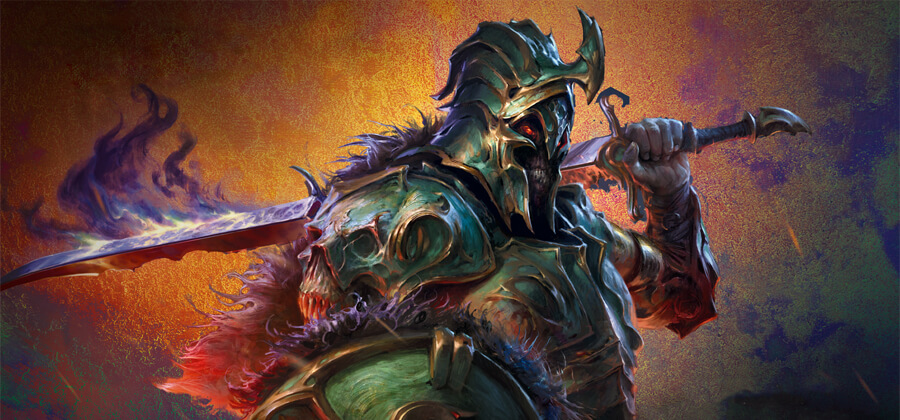
The Basics
Modern is a constructed format. Decks are a minimum of 60 cards, with a sideboard of up to 15 additional cards. Modern was created when Wizards of the Coast introduced the “modern” card frame with the Mirrodin card set, back in 2003. The format does not rotate, so cards printed in Mirrodin, and most cards printed since, are legal. That’s some 17,000 unique cards, so you have a lot of room to brew. Some cards are banned in Modern, and some cards printed with the new frame are not legal (cards from some Commander sets, Unhinged cards, some Secret Lairs, etc). The easiest way to check whether a card is Modern-legal is to check Wizards official card database Gatherer – Magic: The Gathering (wizards.com) or a similar site like Scryfall.
With 17,000 cards in the format, good decks tend to have a lot of synergy. That synergy can be tribal: Goblins, Merfolk, Spirits, Elementals and Humans are all solid archetypes. The synergy can be more direct: Modern has literally dozens of competitive combo decks. Modern also has both a wide range of midrange decks and some solid control archetypes. For those of you that like it hot, burn decks have always been a staple of the format and likely always will be.
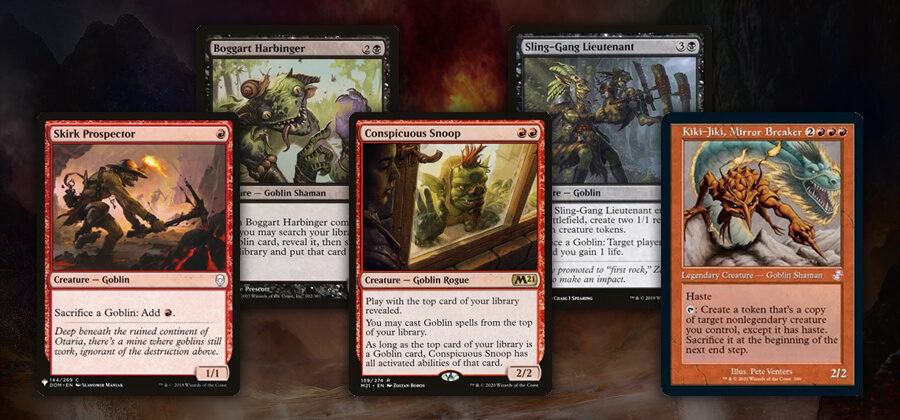
Viable Options Galore
Modern is a wide-open format. As I write this, at least a dozen decks are considered Tier One, and no single deck makes up more than 12% of the competitive metagame. Several dozen more decks are capable of consistently good performances and winning large events. Several websites (such as MTGTop8 and MTGDecks.net) can provide an overview of the metagame, and decklists for pretty much anything that is being widely played. People are brewing new decks—or innovating on existing archetypes—all the time. New decks appear constantly, but certain archetypes are always with us. Personally, I have a Tron deck that I have played for literally decades.
Modern is a great format, but it can be difficult to find a place to start. My suggestion is to decide what sort of deck you really enjoy, then look for decklists on the above websites that match that build. You don’t have to copy an existing deck, but those decklists can give you good ideas for constructing, and especially for sideboard cards you may need.
Let’s cover some basics. These observations were true when the Modern format was created and are likely to be true going forward. Consider this a very general overview.
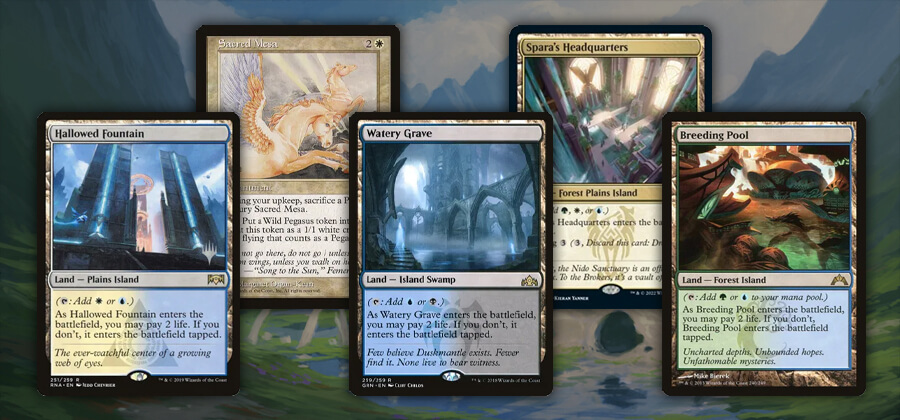
The Mana Bases are Amazing
Modern is a colorful format. Domain decks have no problem getting all five land types into play on turn two. The mana is just that good because of the great Modern triple threat: Fetchlands, Shocklands and Triomes. With those in the format, you can play literally any combination of colors.
Fetchlands, such as Flooded Strand, can be sacrificed to get one of two types of basic land types: Plains, Island, Swamp, Mountain or Forest. Flooded Strand can get either a Plains or an Island. Since you have Fetchlands in every color pair, and since they can get Shocklands and Triomes as well as basic lands, any Fetchland can fetch literally any color needed.
The Shocklands, such as Hallowed Fountain, are a series of lands that are each two land-type and come into play tapped, or—if you pay two life—untapped. Hallowed Fountain is both a Plains and an Island and would be a fine target for a Flooded Strand. However, a Flooded Strand can fetch any Shockland that has either Plains or Island as one of its types. A Flooded Strand could get a Watery Grave (giving you an Island and a Swamp) a Sacred Mesa (Plains and Mountain) or a Breeding Pool (Island and Forest). Any Fetchland can—given the right Shockland—give you any color at all.
Finally, if that is not enough, we also have Triomes—lands that are three land types. They are fetchable. For example, Spara’s Headquarters is a Forest, Plains and Island. Wizards of the Coast has given us Triomes that cover all color combinations. Just to add the cherry on top, the Triomes cycle if you don’t need them.
The Power—and Cost—of Lands
The combination of Fetchlands, Shocklands and Triomes gives you incredible options. I have routinely played Territorial Kavu—a creature whose power and toughness are equal to the basic land types you have in play—as a 5/5 on turn two. That’s pretty good!
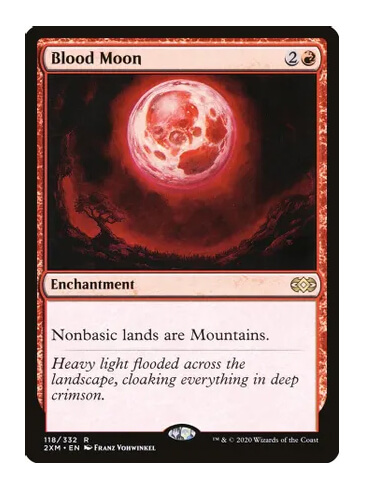
These lands are powerful, and with great power comes great… well, cost. The lands are expensive, but worth it. Fetchlands are the most expensive, but they are still the place to start. Any two-color deck will benefit from having them, and any three-color or more-color decks pretty much need them. You can skimp on the Shocklands and Triomes—most three-color decks play just a couple Shocklands in each pair and one or two Triomes, but generally run 8-12 Fetchlands. Costly, yes, but once you own them you’ll use them in pretty much every Modern deck you build, even mono-colored decks.
One word of warning, however. Because the Modern format has a ton of Fetchlands, Shocklands and specialty lands, some decks prey on that diversity. Blood Moon (all non-basic lands are Mountains instead) is commonly played. So is Magus of the Moon—a Blood Moon on legs. To play around Blood Moon effects, make sure you have one or two on-color basic lands in you decklist and fetch them early if your opponent starts fetching basics and Mountains.
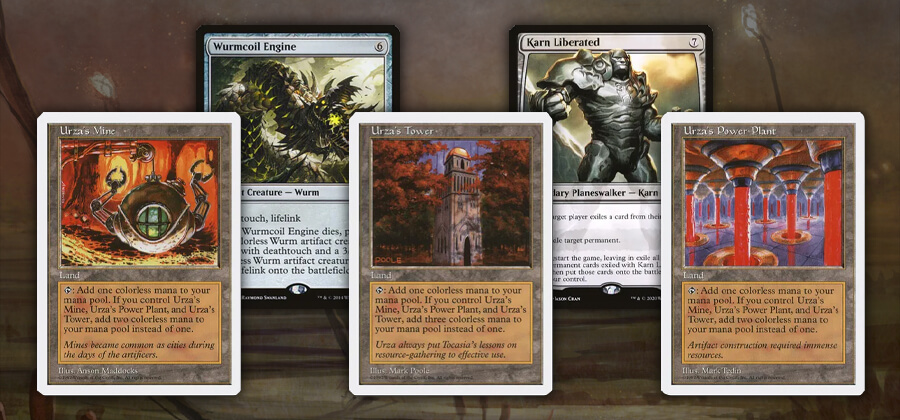
Cheating on Mana
Modern MtG decks generate not just many colors, but a lot of mana. Some decks play lands that tap for more than one mana or play more than one land per turn. These decks pump out large creatures, costly enchantments and powerful planeswalkers on turns three or four.
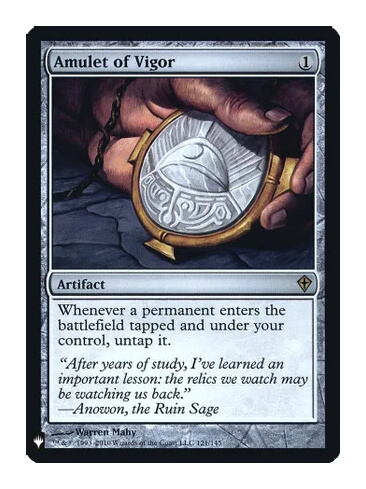
For example, the Tron deck is built to get Urza’s Mine, Urza’s Tower and Urza’s Power Plant into play consistently on turn three. Together, the lands produce seven mana, and the deck has plenty of colorless cards that can use that mana, starting with Karn Liberated and Wurmcoil Engine. The Tron decks famously mulligan well and can be very consistent.
Other decks also “cheat” on mana to power out powerful cards. The Amulet of Vigor decks can cast Primeval Titan as early as turn three. A turn-three Titan is pretty brutal. Scam decks cheat out elementals. Affinity decks rely on artifact lands to cast cards like Frogmite for free and Thought Monitor for almost nothing, and the archetype continues to perform. And the list goes on.
Decks like this are another reason that many decks pack Blood Moon, Magus of the Moon, Leonin Arbiter, or similar cards in their sideboards. If finances are tight, you can play cards like Cleansing Wildfire (a common) or Damping Sphere to at least slow down Tron and Amulet.
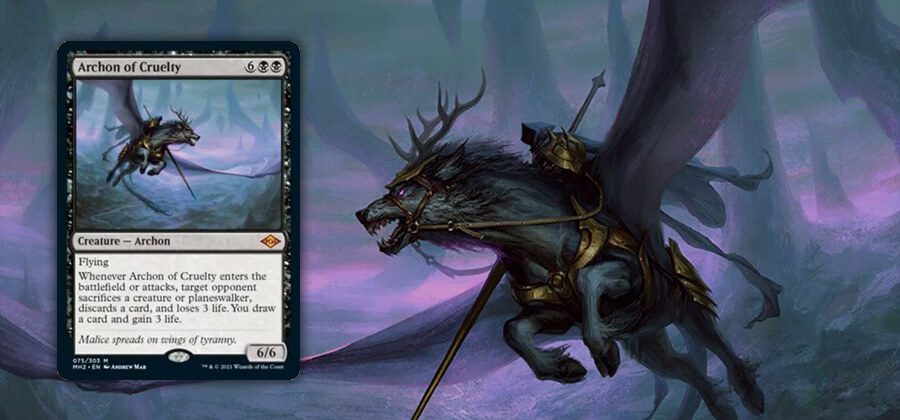
Coming Back from the Dead
In Modern MtG, cards may go to the graveyard, but they don’t always stay there. Some decks are built around graveyard interactions – others just use their graveyards as a resource. Even if your deck does not exploit your graveyard, you should have answers for those decks that do.
The OG graveyard strategy is reanimation: get a massive creature into the graveyard, then return it to play. Twenty-five years ago, the card Reanimate would reanimate Spirit of the Night. Modern decks have better ways to reanimate better creatures, but the principle is the same. A monster like Archon of Cruelty hitting play on turn two is hard to beat.
Other decks work to fill the graveyard, then use the cards in the graveyard to let them cast delve cards like Murktide Regent quickly and easily. Murktide decks play a lot of cheap cantrips to fill their graveyard, then cast huge Murktides quickly and often.
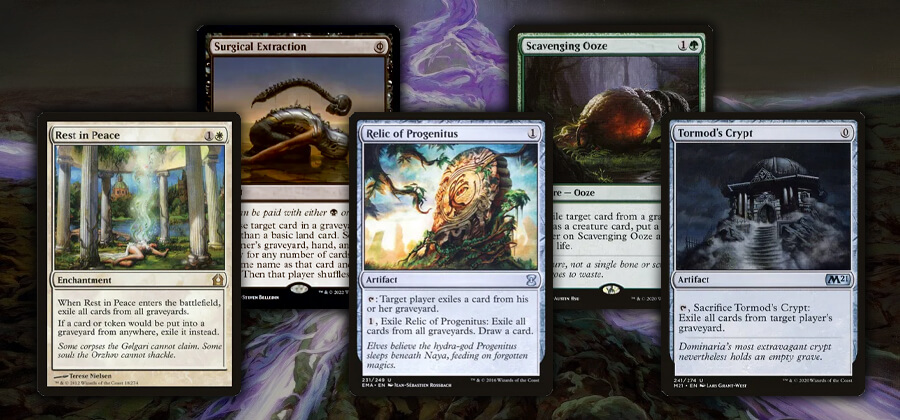
Dredging & Sideboard
Finally, there is Dredge. Dredge cards (like Stinkweed Imp) can be cast as normal, but Dredge decks are not normal. Dredge cards can be returned to hand by milling. The dredge decks don’t really care about the returned cards—they just want to mill their libraries. Some spells (like Creeping Chill) can be cast when dumped into a graveyard. Other creatures (like Prized Amalgam and Narcomoeba) return to play when milled. The combination makes Dredge a hard deck to beat game one, and hard to beat game two unless you have an appropriate sideboard.
Which brings us to sideboard cards. Several sideboard cards, like Leyline of the Void and Rest in Peace, exile any cards headed for the graveyard. Other cards exile graveyards when activated, like Relic of Progenitus and Tormod’s Crypt. Still others let you remove cards one at a time, like Scavenging Ooze or Surgical Extraction. Exactly which you choose to sideboard depends on your colors—and budget—but you want something. Modern MtG does love its graveyards.
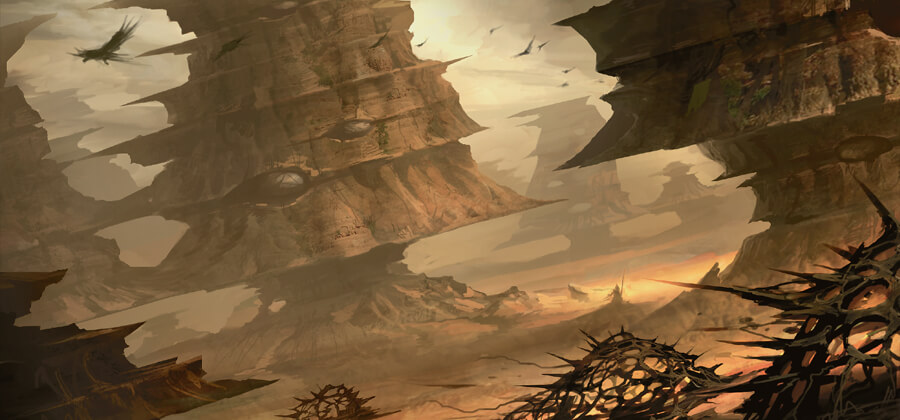
The Modern Horizons Sets
Wizards has printed two sets of cards designed for specifically for Modern MtG: Modern Horizons I and Modern Horizons II. These were extremely powerful sets, and they gave rise to many powerful archetypes. Modern Horizon II added some cards that are still rocking the format. Mythic rares from the sets are especially expensive, but immensely powerful. Let’s look at a few that you will see anytime you play Modern.
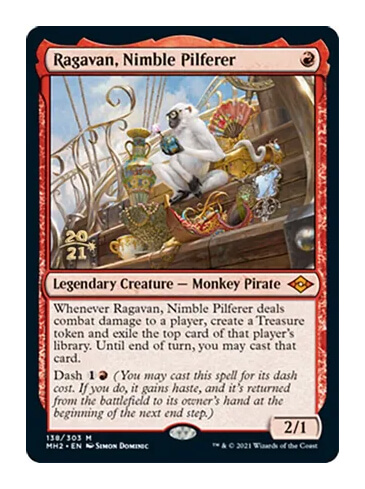
Ragavan, Nimble Pilferer is almost certainly the best one-drop in the format. It fits in most aggro decks, if the pilot can afford it. Getting hit by Ragavan hurts, but the card can be beaten. Ragavan is a strong reason to play cheap and effective removal.
I have already mentioned Murktide Regent, another highly impactful Mythic from Modern Horizons II. And that set also gave us five elemental incarnations:
Each of these has a very impactful comes-into-play ability, and each can be evoked by exiling a card of the same color from your hand.
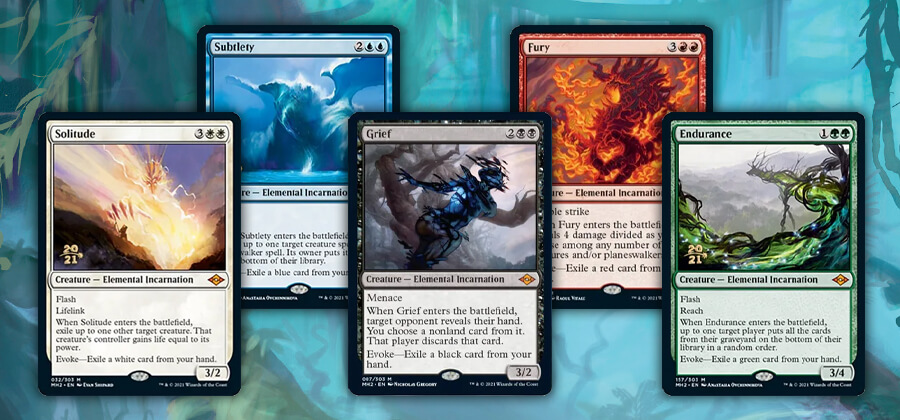
The “Scam” decks evoke elementals as early as turn one, then use “flicker” effects (like Ephemerate) to trigger their ability a second time and get around the sacrifice effect.
Scam decks are quite powerful.
Modern Horizons’ Synergy & Cost
Modern Horizons cards are staples of Modern MtG. You will face them, but they are not unbeatable. You will learn how to play against and around them. More importantly, the format continues to evolve, and every new set has a couple cards that make their way into Modern. Not a lot—it takes some real power or synergy to beat out the 17,000+ cards already in the format—but some.
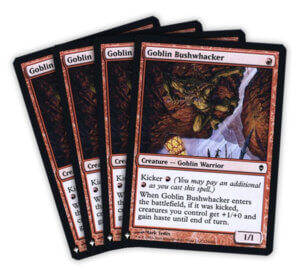
Make no mistake, Modern MtG is not a cheap format. The mana bases are expensive. The chase cards are expensive. But you can get into the format cheaply, play for a while, then decide whether you want to invest more. Now I know that many writers have said, for pretty much every format ever, “budget decks are playable.” In Modern, this is actually true.
When Noble Knight Games asked me to start running Modern events at the store, I didn’t have a deck. I had sold a bunch of my cards, and I was missing a lot of staples—including everything from the Modern Horizons sets. I “invested” in a deck called 12Whack, which featured a bunch of Goblin Bushwhacker clones. The entire deck cost less than $75, including sideboard. I spent some time learning the deck, and it paid off—netting me several event wins. I now have several other decks, including expensive decks full of Fetchlands and chase cards, but I still dust off 12Whack on occasion.
Getting into the Format
Hopefully, we’ve piqued your interest in what I think it the best 60-card format going. If you want to join us, here are a few tips.
Think About Deck Type
First, think about what type of deck you want to play, and then do some research. Look at the websites with metagame breakdown, and see what other people are doing with your idea. Let’s say you want to build elves. There are several different types of Modern Elves decks out there. You don’t have to copy any of them, but it may be helpful to remember that Reclamation Sage is a potential budget sideboard card for an elf deck. It helps to know what people do with decks like the one you want to build.
Get Meta (not the company)
Next, learn something about the metagame. It helps to know what your opponents will be doing. A number of Twitch streamers and YouTubers make Modern content. Some, like Aspiring Spike, are almost exclusively Modern MtG players. If nothing else, watching these players pilot a deck through a Modern league will give you some idea of the diversity of the format.
If You’ve Got the Cash
If your budget allows, buy a booster box of Modern Horizons II. It’s not cheap, but the set has a ton of cards you will need. It has Fetchlands. It has those Mythics, but more importantly, it has a lot of commons and uncommons that are quite important. Unholy Heat is great removal and a staple in many decks—and a common. I have bought two boxes, and they gave me a lot of cards I needed, plus some really good trade fodder. Personally, I made a solid profit on both boxes.
Finally, have fun. Modern MtG is a diverse and exciting format—try it out!

Written by Pete Jahn
Pete started writing for Magic: the Gathering websites in 1998. He won his first competitive match at a Pro Tour qualifier in 1999, when his Round 5 opponent failed to show up. Since then, he has been to over a hundred Grand Prix, 15 Pro Tours and 5 World Championships, most often as a judge. He played in the first Community Cup against Wizards employees—victoriously—and was a playtester for the Mirrodin card set. About that last thing, Pete would like to apologize for Affinity and say it wasn’t really his fault.
[ Browse all Magic: the Gathering ]
